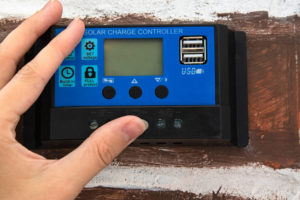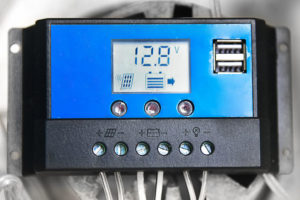Solar energy is a powerful and sustainable source of electricity, and solar panels have become increasingly popular for generating clean energy. One crucial technology has emerged to maximize the efficiency of solar panels: Maximum Power Point Tracking (MPPT). This comprehensive article will delve deep into the world of MPPT, exploring what it is, how it works, and its significant advantages in solar energy systems.
Contents
- 1 Key Takeaways
- 2 The Basics of MPPT
- 3 Benefits of MPPT Charge Controllers
- 4 Types of MPPT Charge Controllers
- 5 How MPPT Charge Controllers Work
- 6 Selecting the Right MPPT Charge Controller
- 7 Installation and Setup
- 8 Maximum Power Point Technology Advancements
- 9 Case Study: Enhancing Solar Efficiency with MPPT Technology in a Residential Setup
- 10 Expert Insights From Our Solar Panel Installers About Maximum Power Point Tracking (MPPT)
- 11 Experience Solar Excellence with Us!
- 12 Conclusion
Key Takeaways
- MPPT technology optimizes solar panel performance by continuously adjusting voltage and current to capture the maximum available power, making solar panels more efficient even in challenging conditions.
- MPPT charge controllers increase energy harvest, extend battery lifespan, and come in various types to suit different solar system setups.
- Choosing the right MPPT controller involves considering panel specifications, battery voltage, system size, and environmental conditions, while proper installation and maintenance are crucial for optimal performance.
The Basics of MPPT
Maximum PowerPoint Tracking (MPPT) is a critical technology in photovoltaic (PV) systems, particularly solar panels. It represents a smart electronic system designed to optimize the energy output of solar panels. The primary objective of MPPT is to continuously track and adjust the operating point of solar panels to capture the maximum available power.
MPPT is of paramount importance for solar panels due to the dynamic nature of their energy generation. Solar panels produce direct current (DC) electricity when exposed to sunlight. However, factors such as sunlight intensity, temperature, and shading can cause fluctuations in power output. In the absence of MPPT, solar panels operate at a fixed voltage, which may not always be the optimal voltage for achieving the highest power output.
Benefits of MPPT Charge Controllers
MPPT charge controllers are central to enhancing the efficiency of solar panels and maximizing energy harvest. Let’s delve into the key advantages they bring to solar energy systems:
MPPT controllers play a pivotal role in optimizing solar panel efficiency. These controllers ensure that solar panels operate at peak efficiency by adjusting the voltage and current output to match the panel’s Maximum Power Point (MPP). Even under suboptimal conditions, such as partial shading or temperature fluctuations, solar panels equipped with MPPT controllers consistently produce more energy than systems without this technology.
Furthermore, MPPT controllers significantly increase energy harvest. By continuously fine-tuning the operating point of the solar panels, they ensure that every ray of sunlight is efficiently converted into usable electricity. This results in a higher energy yield over time, making solar systems more productive and cost-effective.
In addition to boosting energy production, MPPT controllers extend the lifespan of battery banks in solar systems with energy storage. These controllers deliver the optimal charging voltage and current, preventing overcharging and undercharging. Preserving the battery’s health translates into long-term benefits and cost savings.

Types of MPPT Charge Controllers
MPPT charge controllers come in various types, each offering distinct features and benefits to cater to different solar system setups. Here’s an overview of the most common types:
PWM (Pulse Width Modulation) Charge Controllers
PWM charge controllers represent the simplest type of MPPT controllers. They regulate battery charging by rapidly switching the solar panel’s output on and off to maintain the desired voltage.
DC-DC Converters
DC-DC converters are a more advanced category of MPPT controllers. They efficiently adjust the voltage and current from the solar panel to match the battery’s requirements, offering superior energy conversion efficiency compared to PWM controllers.
Boost Converters
Boost converters provide yet another type of MPPT controller. They step up the voltage from the solar panel to match the battery’s voltage, ensuring efficient energy transfer.
How MPPT Charge Controllers Work
Understanding how MPPT charge controllers operate is essential for appreciating their significance in solar systems:
MPPT controllers continuously monitor the voltage and current output of the solar panels. By processing this real-time data, they calculate the power output and adjust the operating point accordingly to maximize power generation. This dynamic adjustment is crucial, especially when environmental conditions change, such as cloud cover or shading.
Moreover, MPPT charge controllers are specifically designed to overcome challenges posed by environmental factors. Whether coping with temperature fluctuations or navigating through shading scenarios, these controllers employ advanced algorithms to operate efficiently and maintain optimal performance.
Selecting the Right MPPT Charge Controller
Selecting the appropriate MPPT charge controller for your solar system is critical. Several key factors should be taken into account:
- Panel Voltage and Current: The specifications of your solar panels, including their voltage and current ratings, will determine the compatibility of the MPPT controller.
- Battery Voltage: Ensuring that the MPPT controller can provide the correct voltage for your battery bank is essential to prevent damage or undercharging.
- System Size: The size of your solar array and battery bank plays a pivotal role in influencing the choice of an MPPT controller. It should be capable of handling the load effectively.
- Environmental Conditions: Consider the local climate and environmental conditions, as some MPPT controllers are better suited for extreme temperatures or high humidity.
Installation and Setup
The installation and setup of an MPPT charge controller are crucial steps in ensuring optimal performance:
Proper wiring and connection of the MPPT controller to the solar panels and battery bank are fundamental for safe and efficient installation. It’s imperative to adhere to manufacturer guidelines and recommendations to ensure the system functions as intended.
Additionally, most MPPT controllers require initial configuration and calibration to align with the specific parameters of your solar system. This calibration is essential for maximizing energy production and ensuring the controller operates optimally throughout its lifecycle.

Maximum Power Point Technology Advancements
As technology continues to advance, so does MPPT technology. Several emerging trends are reshaping the landscape of MPPT technology:
Improved Algorithm
Developing more sophisticated algorithms enables MPPT controllers to make quicker and more precise adjustments to changing conditions. This enhances their overall efficiency and adaptability.
Cold Weather Optimization
Newer MPPT controllers are engineered to operate efficiently in cold weather conditions. They ensure consistent energy production even in freezing temperatures, making them suitable for a broader range of climates.
AC-Coupled Systems
AC-coupled MPPT controllers are gaining popularity due to their flexibility and compatibility with grid-tied systems. This trend is expanding the horizons of MPPT technology and its applications.
Case Study: Enhancing Solar Efficiency with MPPT Technology in a Residential Setup
Background
At Solar Panels Network USA, we are dedicated to providing innovative solar solutions that maximize energy efficiency and sustainability. Maximum Power Point Tracking (MPPT) technology is a key advancement in our efforts to optimize solar panel performance. This case study illustrates the successful implementation of MPPT technology in a residential solar system, highlighting its benefits and the process involved.
Project Overview
A residential client sought to enhance their solar panel system’s efficiency and increase their energy harvest. The client’s primary objective was to ensure their solar panels operated at peak efficiency, even under varying environmental conditions. To meet this goal, we proposed integrating MPPT charge controllers into their existing solar setup.
Implementation
- Selecting MPPT Charge Controllers: We selected advanced MPPT charge controllers tailored to the specifications of the client’s solar panels and battery system. These controllers were chosen for their ability to optimize energy conversion and adapt to changing sunlight conditions.
- Proper Installation Techniques: Proper wiring and connection of the MPPT controllers to the solar panels and battery bank were ensured by our team, following manufacturer guidelines. We performed initial configuration and calibration of the MPPT controllers to align with the specific parameters of the client’s solar system. This calibration was essential for maximizing energy production.
- Ongoing Monitoring and Maintenance: We implemented a regular monitoring schedule using advanced software to track the performance of the MPPT controllers and solar panels. Routine maintenance was conducted to ensure the optimal functioning of the system, including checking connections and cleaning components to prevent any potential issues.
Results
- Increased Energy Harvest: The integration of MPPT controllers resulted in a significant increase in energy output, even under suboptimal conditions such as partial shading or temperature fluctuations. The client experienced higher overall energy efficiency and a greater return on their solar investment.
- Extended Battery Lifespan: By delivering the optimal charging voltage and current, the MPPT controllers extended the lifespan of the client’s battery storage system. The improved battery health translated into long-term cost savings and reliable energy storage.
- Cost Savings and ROI: The enhanced efficiency and extended battery life resulted in lower operational costs for the client. The client achieved a faster return on investment due to the increased energy harvest and reduced maintenance needs.
- Client Satisfaction: The client expressed high satisfaction with the improved performance of their solar system, noting the significant benefits of MPPT technology. Our comprehensive approach and ongoing support ensured the client’s confidence in their solar energy solution.
Summary
This case study demonstrates the transformative impact of Maximum Power Point Tracking (MPPT) technology on residential solar systems. By continuously optimizing voltage and current, MPPT controllers maximize energy harvest, extend battery lifespan, and enhance overall system efficiency. At Solar Panels Network USA, our commitment to cutting-edge technology and meticulous implementation ensures our clients receive the best solar solutions available. MPPT technology is a game-changer in solar energy, providing sustainable and efficient power generation for a greener future.
Expert Insights From Our Solar Panel Installers About Maximum Power Point Tracking (MPPT)
MPPT technology is essential for optimizing solar panel performance, particularly in regions with variable sunlight. It ensures maximum energy harvest by continuously adjusting to the optimal voltage and current levels.
Senior Solar Installer
By utilizing MPPT charge controllers, we’ve significantly increased the efficiency of our solar installations, even under challenging conditions such as partial shading or temperature fluctuations.
Lead Solar Technician
Proper installation and regular maintenance of MPPT systems are crucial. This technology not only boosts energy output but also extends the lifespan of battery storage systems, providing long-term benefits to our clients.
Chief Solar Engineer
Experience Solar Excellence with Us!
Trust in Solar Panels Network USA, where our seasoned experts deliver top-quality solar solutions for homes and businesses nationwide. With a legacy of countless successful installations and a commitment to sustainable energy, we’re your reliable partner in the solar journey. Ready for a brighter, eco-friendly future? Call us now at (855) 427-0058 and harness the power of the sun!
Conclusion
Maximum Power Point Tracking (MPPT) is a game-changer in solar energy. It empowers solar panels to operate efficiently, even when facing challenging environmental conditions. Investing in an MPPT charge controller can optimize energy production, extend battery lifespan, and contribute to a more sustainable future. Make the most of your solar system by harnessing the power of MPPT technology.
About the Author
Solar Panels Network USA stands at the forefront of solar energy solutions, driven by a team of seasoned solar engineers and energy consultants. With over decades of experience in delivering high-quality solar installations and maintenance, we are committed to promoting sustainable energy through customer-centric, tailored solutions. Our articles reflect this commitment, crafted collaboratively by experts to provide accurate, up-to-date insights into solar technology, ensuring our readers are well-informed and empowered in their solar energy decisions.
